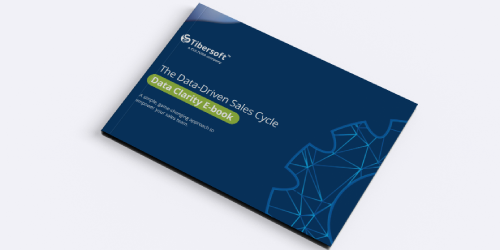Focusing on the challenges of data sources and management, Dean Rallo, Director of Client Solutions at Tibersoft and Lee Swearingin, a seasoned consultant in the consumer-packaged goods industry, continue the engaging conversation they started in Navigating Foodservice Data Complexity: Insights and Solutions – Part 1.
Their conversation emphasizes the need for leveraging insights and data-driven strategies for driving growth, improving efficiency across teams, measuring the return on your investment in data & insights, and how to optimize your analytical tech stack in the foodservice manufacturing industry.
Dean Rallo: Let’s talk about how manufacturers measure the ROI of investing in insights and how they can ensure that the insights they gather and act upon are providing a return on investment.
Lee Swearingin: The cost of investment, whether through Tibersoft or in-house, needs to be considered along with the timeline for ROI. It’s important for the leadership team to believe in transparency and involve end users to understand their wins. They need to determine if the data is actually being used and if the wins are a result of the insights or just luck. Transparent discussions are necessary to find out what’s really going on.
Dean Rallo: I agree. It’s not enough to have great insights; they need to be actively used by the sales and finance teams. ROI goes beyond just having the insights themselves.
Lee Swearingin: Exactly. If leadership invests in data but it’s not being used, there should be an honest discussion to identify the reasons. Are the sales teams using another data source? Are there functionality or user experience issues? In my experience, continuous communication and feedback are important for a measurable ROI.
Dean Rallo: How do you suggest foodservice manufacturers measure the ROI on data insights?
Lee Swearingin: There’s no simple calculation for determining ROI. It’s more complex than that. The data and insights are being used across the entire organization, and not just by the sales team. The direction can come from different areas, but ultimately, driving growth and sales is crucial. Finance and marketing are functional support, while the field teams are responsible for driving growth. The insights can be applied across different functions by integrating consumer insights data with operator volume data, for example.
Dean Rallo: Absolutely. The intangible benefits, such as improved understanding of the business and control over trade budgets by addressing double dips and contributing to profitability. On the topic of double dips, how do you define double dips and how do they impact foodservice manufacturers?
Lee Swearingin: In foodservice trade management, the term “double dip” refers to a practice where an operator is receiving offers, special deals, discounts, or incentives from both the distributor and the FMC/GPO on the same delivered case. The manufacturer is paying the distributor an incentive on a case of product and the FMC/GPO is billing the manufacturer for the same case that the operator received from the distributor. This tactic is known as a “double dip” because it allows both parties to benefit from the promotion, essentially dipping into the deal or discount twice.
Dean Rallo: Any examples you can share?
Lee Swearingin: Let’s say a distributor provides a discount on a certain brand of soft drinks to a restaurant. At the same time, the FMC/GPO that the restaurant belongs to sends a bill for the discount to the manufacturer as well. Two separate discounts for the same case.
Dean Rallo: At Tibersoft, we joke that double dips are good for ice cream but bad for trade budgets. Many companies don’t even know how much money they’re losing due to double dips because they lack visibility. Quantifying this issue reveals significant financial impact, often reaching hundreds or thousands of dollars. Double dips affect trade spend across all manufacturers, regardless of size or segment. Addressing this problem can free up funds that can be used elsewhere, providing a substantial ROI for implementing a solution.
Lee Swearingin: I agree, identifying and addressing double dips not only safeguards trade budgets but also holds immense value for financial management. Depending on the size of the trade budget and the percentage being double dipped, it can have a significant impact on the organization. The savings from double dipping can be reinvested in various areas.
Dean Rallo: Definitely. I want to shift gears here to talk about technology solutions. Many foodservice manufacturers already incorporate CRM and TPM systems into their tech stack. Is there any other solution that can further enhance profitability and facilitate growth?
Lee Swearingin: Certainly. So, Tibersoft seamlessly integrates into the existing tech stack by complementing established TPM systems such as Blacksmith, rather than replacing them. Moreover, it works harmoniously with CRM systems to provide valuable insights. Tibersoft’s flexibility allows it to work with any manufacturer, irrespective of their current systems or data development stage. This adaptability underscores our commitment to empowering all manufacturers with a solution tailored to their unique needs.
Dean Rallo: Right. And many of our clients have a TPM and CRM, but we can also assist manufacturers without a TPM system or CRM. We provide insights and dashboards independently. Our goal is to work well with other systems and offer customized solutions to manufacturers. Tibersoft can work with manufacturers at different stages and provide valuable insights and data, regardless of their current systems or requirements.
Lee Swearingin: That’s a key point. Tibersoft works well with manufacturers at different stages, regardless of their current systems or data development, which allows them to have a more customized solution that meets their specific needs.
Dean Rallo: Lee, it’s been a pleasure discussing these important aspects with you. I believe our insights will be valuable for manufacturers looking to maximize their ROI in data and data insights.
Lee Swearingin: I couldn’t agree more, Dean. Thank you for the engaging conversation.





